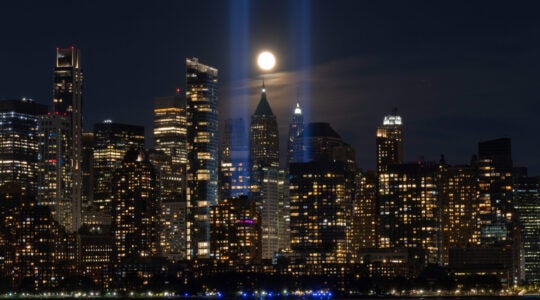Robinson’s Arch, the only area of the Western Wall that is government-approved for prayer without a mechitzah, will take center stage Friday evening (May 10) when it serves as the site for what is being billed as “the first Kabbalat Shabbat prayer service at the Egalitarian Kotel.”
Jeff Feig, the New York businessman (and Jewish Week board member) who organized and helped sponsor the project, hopes the weekly service will become a permanent and festive fixture of the Kotel, attracting large crowds of Jews from all walks of Jewish life.
“We believe it will be a spirited and spiritual place where families can pray together and women can participate with a full voice,” Feig said on launching the project, which is being coordinated by the Masorti (Israeli Conservative) movement and a number of partners, including Reform, pluralistic and secular organizations.
Beyond the spiritual aspect, the project, if successful, could play a key role in diaspora Jewry’s continuing campaign for egalitarian prayer at Judaism’s holiest site. Lobbying by American Jewish leaders seems to have reached the limits of its influence when the religious parties of Netanyahu coalition forced the prime minister to renege two years ago on the coalition’s promise of a compromise on the Kotel issue; they had threatened to bring down the government if the compromise was enacted.
The next Netanyahu coalition is expected to be equally insistent on the issue, and Israeli advocates for gender equality in prayer have long noted that the best and perhaps only way to advance the diaspora cause is to show Israeli society and Knesset members that there is a real interest and need for egalitarian prayer at the Kotel. A large and consistent turnout for Friday evening prayer at Robinson’s Arch could be influential, suggesting that the phrase “facts on the ground” applies to the Kotel as well as settlement communities in the West Bank.
Feig’s interest, though, is rooted in a personal quest to fuse liberal Judaism’s modernized prayer with the traditions and history of Judaism’s holiest site. He said the genesis of the project began during a family trip to Israel in 2011, when he decided to go to the Western Wall for Friday evening services and was deeply impressed with the joyous atmosphere — large crowds of men praying, singing and dancing.
“It was such a happy Jewish experience,” he said, that he brought his young son there and decided to come to the Kotel on every visit when he was in Jerusalem for Shabbat, which he did for years. But he came to realize that the experience was not the same for his wife, Michelle, who felt left out. She noted that the mood on the women’s side of the Wall was far more sedate.
Fast forward six years to June 2017. Feig was in Israel as part of a Wexner Fellowship program just days after the collapse of the deal between the Israeli government and diaspora groups over equal prayer at the Kotel. After services at the traditional Kotel area, Feig’s group went to check out Robinson’s Arch, the long-overshadowed section of the Kotel at its southern end, which has been spruced up in recent years and used most often by non-Orthodox groups for bar and bat mitzvah services.
In contrast to the celebratory mood on the men’s side of the main section of the Wall, “it felt dead,” Feig said.
“I thought, deal or no deal, why aren’t more people using” Robinson’s Arch for Friday night prayer?
That led him to a series of discussions with non-Orthodox leaders in Israel and the U.S. and a commitment to initiate a weekly Kabbalat Shabbat service “without barriers,” as described in promotional material for the project.
Yizhar Hess of the Masorti movement, which has facilitated services at Robinson’s Arch since 2000, said he expects the Friday evening service to start small, with perhaps 50 to 100 people at first, and grow as more people, both tourists and Israelis, learn of it.
Each week, he said, the service will be led by different rabbinic figures, according to their own style, primarily in Hebrew but also with English. The approach, he said, is to be “very open and pluralistic — everyone is welcome.”
The initial service will be led by Rabbi Yerach Meirsdorf, a Schechter Institute graduate and rabbi of the Noam youth movement in Israel, and his wife, Navah Meirsdorf, a rabbinical student at Schechter.
Hess said American rabbis on group missions will be asked to lead the services on occasion. He pointed out that Robinson’s Arch attracts more than 100,000 people a year to various lifecycle events, though it is often under-utilized during the week. Travel agents, tour leaders, rabbis, educators and officials of the liberal streams are being told about the new project (www.ezratisrael.com/kabbalatshabbat).
Hess does not expect any disturbances from ultra-Orthodox groups or individuals who have disrupted services held by Women of the Wall each month at the main section of the Kotel.
“Everyone should feel at home here,” he said. “Sometimes you need the right person [referring to Feig] to come up with the right idea at the right time.”
“I’m excited to be a part of it,” Feig noted, adding that initiating the Friday evening service was “a small idea,” but the larger one is to “open up the Kotel” to many Jews who might not otherwise come.
“Symbols are important in Jewish life, and the Kotel has been such a major symbol for thousands of years,” Feig said, expressing concern that the site was “at risk” of being co-opted by one segment of the Jewish community.
“The Kotel was always a point of imagination and yearning” for all, he said, and “we hope to revive it” for those who have felt forsaken.
The New York Jewish Week brings you the stories behind the headlines, keeping you connected to Jewish life in New York. Help sustain the reporting you trust by donating today.





